A CONVERSATION WITH STEVE WANNA
In the Eternity of an Instant: Mixed Media by Steve Wanna
Margaret W. & Joseph L. Fisher Art Gallery
Schlesinger Concert Hall & Arts Center
Please join us for an Artist Talk – August 17th, 2019 12PM-3PM
How have your personal experiences impacted your art?
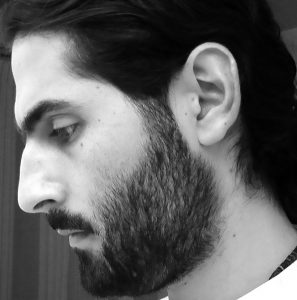 That’s a difficult question to answer for me because I don’t often tie my personal experiences to my work. I immigrated to the U.S. as a teenager and have been straddling two cultures ever since. Yet I don’t feel like I belong fully in either. I suppose this sense of not belonging is pretty common among artists. I’m also a contemplative person by nature and that definitely seeps into my work in big ways. My current worldview is largely informed by science, mathematics and Buddhism. I firmly believe in statistics and coincidence—the business of fate and whatnot makes no sense to me. This has the largest influence on my art by far. A lot of my work has elements of controlled randomness, whether in the decisions surrounding the work, the process of making it or the final result itself.
That’s a difficult question to answer for me because I don’t often tie my personal experiences to my work. I immigrated to the U.S. as a teenager and have been straddling two cultures ever since. Yet I don’t feel like I belong fully in either. I suppose this sense of not belonging is pretty common among artists. I’m also a contemplative person by nature and that definitely seeps into my work in big ways. My current worldview is largely informed by science, mathematics and Buddhism. I firmly believe in statistics and coincidence—the business of fate and whatnot makes no sense to me. This has the largest influence on my art by far. A lot of my work has elements of controlled randomness, whether in the decisions surrounding the work, the process of making it or the final result itself.
Where did you go to school?
I started out taking classes at Northern Virginia Community College when I immigrated here with my family. I transferred to James Madison University to complete my undergraduate and Masters in Music Composition. After that I went on to the University of Maryland to work on my doctorate in Composition with a focus on electronic music, followed by a year-long postdoc at a studio in Paris. That year was very important in that it afforded me a period of incubation and reflection. A lot fell in place for me over the course of that year. I’ve turned to visual and multidisciplinary art recently, and am self-taught—it’s another way I feel like I straddle two cultures, not fully fitting into either. Robert Irwin is another one who’s work and writings resonate with me.
Who were and our your creative influences?
My formal education is in music. My biggest influences for the past decade or so have been Iannis Xenakis and John Cage. They both approached randomness and stochastics from slightly different perspectives. Both worked with processes that removed them from the making of the work, but Xenakis was willing to manipulate the results of his processes to achieve slightly more specific goals, while Cage was willing to completely surrender the results to the processes that yielded them. My aesthetic falls somewhere between the two.
You mentioned that the Myths of Creation series was influenced by images from the Hubble telescope. Can you talk more about how scientific thought has impacted your art?
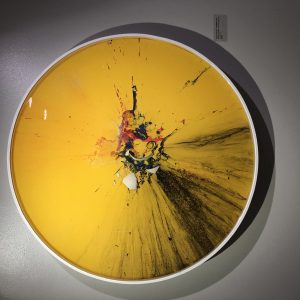 Science has had a huge impact on my thinking, both in art and in life. My work isn’t scientific per se, but definitely inspired by certain principals like systems theory, swarm intelligence, and game theory. I also use technology in some of my work, but there’s nothing particularly unusual about that. When the Hubble images started coming out, I became obsessed. The caption on one simply noted the distance of the exploding star in the image, and it was something in the hundreds of millions of light years away. Aside from being a staggeringly impossible number to fathom, there was something profound and a bit sad and poetic about it: what I was looking at was an event that happened some hundreds of millions of years ago, yet somehow we’re now witnessing it.
Science has had a huge impact on my thinking, both in art and in life. My work isn’t scientific per se, but definitely inspired by certain principals like systems theory, swarm intelligence, and game theory. I also use technology in some of my work, but there’s nothing particularly unusual about that. When the Hubble images started coming out, I became obsessed. The caption on one simply noted the distance of the exploding star in the image, and it was something in the hundreds of millions of light years away. Aside from being a staggeringly impossible number to fathom, there was something profound and a bit sad and poetic about it: what I was looking at was an event that happened some hundreds of millions of years ago, yet somehow we’re now witnessing it.
Describe the process for creating the Myth of Creation pieces.
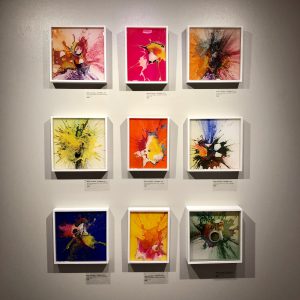 These are pretty involved pieces, and the process has evolved. I start by making the boards and preparing them. Then I make the plaster shells that will hold the pigments. Once all that prep is done, I fill a shell with the various pigments and aggregates. Here I have some measure of control: the order in which I put the material into the shell has some effect on the final result. I’ve built a special enclosure for this step because once I make the drop, the piece has to stay in place until it dries, then I have to spray it with fixative before I can handle it. Because I use powder pigments, I had to come up with a way to spry the fixative indirectly so that it doesn’t blow the powders away. After all that, I add the frame, seal the edges, and pour the resin. The process can take a week or more, yet the actual drop itself happens in a split second. And it’s by far the most exciting part of the process!
These are pretty involved pieces, and the process has evolved. I start by making the boards and preparing them. Then I make the plaster shells that will hold the pigments. Once all that prep is done, I fill a shell with the various pigments and aggregates. Here I have some measure of control: the order in which I put the material into the shell has some effect on the final result. I’ve built a special enclosure for this step because once I make the drop, the piece has to stay in place until it dries, then I have to spray it with fixative before I can handle it. Because I use powder pigments, I had to come up with a way to spry the fixative indirectly so that it doesn’t blow the powders away. After all that, I add the frame, seal the edges, and pour the resin. The process can take a week or more, yet the actual drop itself happens in a split second. And it’s by far the most exciting part of the process!
The series created with synthetic wax – She Who Makes the Moon the Moon is inspired by a poem? Can you talk more about that? How is literature and poetry important to work as an artist?
 A lot of artists find inspiration in literature and poetry. My work is not representational and therefore never a literal (no pun intended) translation of whatever inspired it. I often find inspiration in reading stories or poems and equally in reading scientific articles. I think there are tremendous and fertile sources for the imagination in scientific discovery. That series is inspired by a story entitled “The Distance to the Moon,” from Italo Calvino’s Cosmicomics. Calvino takes modern scientific knowledge, mostly about the formation of the universe, and retroactively creates fantastical stories and myths that work with them in beautiful ways. It pains me when people describe science as cold. The scientific method may be disinterested in how we feel about it, but the creative spark that sets a scientist’s mind on some hypothesis is the same one that every artist and poet feels. It’s a human spark of curiosity about things larger than ourselves that we do not yet understand but might hope to bring forth with a lot of imagination and hard work.
A lot of artists find inspiration in literature and poetry. My work is not representational and therefore never a literal (no pun intended) translation of whatever inspired it. I often find inspiration in reading stories or poems and equally in reading scientific articles. I think there are tremendous and fertile sources for the imagination in scientific discovery. That series is inspired by a story entitled “The Distance to the Moon,” from Italo Calvino’s Cosmicomics. Calvino takes modern scientific knowledge, mostly about the formation of the universe, and retroactively creates fantastical stories and myths that work with them in beautiful ways. It pains me when people describe science as cold. The scientific method may be disinterested in how we feel about it, but the creative spark that sets a scientist’s mind on some hypothesis is the same one that every artist and poet feels. It’s a human spark of curiosity about things larger than ourselves that we do not yet understand but might hope to bring forth with a lot of imagination and hard work.
How has your background in music composition inspired your work?
A lot of my work is concerned with time and processes that center on the passage or capture of time. Time is an integral part of music—sound is a physical phenomenon that is essentially the propagation of vibrations over distance, something that requires time. I find myself creating works that either freeze time through some process, or require time to unfold. I also find myself applying in my visual works a lot of the same aesthetics I’ve developed in my music: an affinity for controlled randomness, an openness to process, a willingness to follow these highly experimental works wherever they need to go.
Describe the process of making “ Come Closer”
This work was the first in a series based in my obsession with shadows. I had a very specific idea in mind and tested a lot of different materials. I played with paper, glass, even tried making some materials from recipes I found. The look I had in mind was that of thin porcelain with light behind it. My partner Tonya suggested having someone make it and that’s what happened. I sent my designs to a ceramic artist and he slip cast them to my specs. The electronics came next. I designed the sounds I wanted using software I’ve used before with other works but I had to get help from my brother who’s an computer engineer in order to realize the works as standalone objects, each with its own microprocessor. We had to work on translating the code to work with the hardware. I then designed the layout of the boards that would go inside the porcelain boxes—they hold a microprocessor, a small speaker, and an LED strip. The small computer runs a program that controls the sound and light. They both ramp up and down at randomly chosen intervals. Each box emits a single pure tone. The combination of all the boxes together creates a complex sound. The piece is quiet and soft, and like many of my works, it’s meant to invite quieted and contemplation. What I find most poetic about it is that because the boxes are independent of each other and are ramping up and down at random intervals, you’ll never hear the same combination of sounds no matter how long you stand there. But the differences in timing are not so huge as to be immediately noticeable. This means the piece effectively looks simple at first glance but you realize there’s actually a lot more to it when you get to know it. This element of discovery is true of a lot of my work. And probably of me, as well…
When people look at your work, what do you hope they get from it? What kind of reaction were you going for when creating this body of work, and what kind of conversation do you hope it provokes?
I hope my work has an impact on people, an impact that is beyond, or rather before words and conversation, the same kind of impact a beautiful sunset might have on one. I’ve always found beauty like that to hit me almost like a physical punch in the gut. For a moment, words fall away and there’s nothing but you and the object and the bare experience. The mind has been foiled by the surprise, arrested for an instant by the experience and impact of beholding that object. Process is something we can talk about, modify, and improve, but impact is beyond words. I guess if someone looks at my work and is clearly impacted by it but has nothing to say that would be okay with me!
What can viewers and art lovers expect from your work in the future?
I’m hoping to move more in the direction of installation work, especially large-scale installations—that’s the kind of work I find most exciting and engaging. I’m continually looking for ways to better present sonic works, so I’ll continue pursuing that. I’ll also likely continue to explore the works and ideas represented in this show.
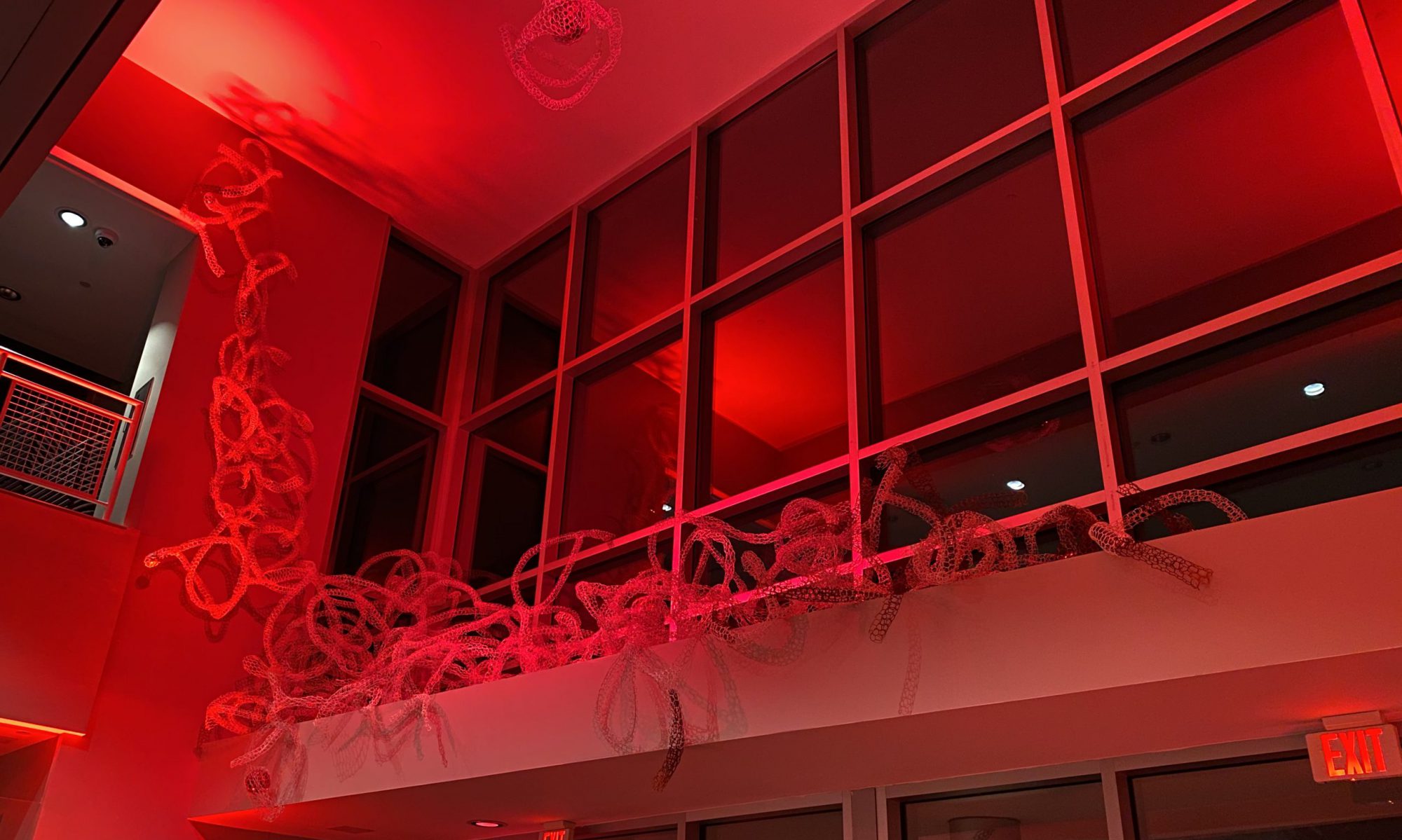

 That’s a difficult question to answer for me because I don’t often tie my personal experiences to my work. I immigrated to the U.S. as a teenager and have been straddling two cultures ever since. Yet I don’t feel like I belong fully in either. I suppose this sense of not belonging is pretty common among artists. I’m also a contemplative person by nature and that definitely seeps into my work in big ways. My current worldview is largely informed by science, mathematics and Buddhism. I firmly believe in statistics and coincidence—the business of fate and whatnot makes no sense to me. This has the largest influence on my art by far. A lot of my work has elements of controlled randomness, whether in the decisions surrounding the work, the process of making it or the final result itself.
That’s a difficult question to answer for me because I don’t often tie my personal experiences to my work. I immigrated to the U.S. as a teenager and have been straddling two cultures ever since. Yet I don’t feel like I belong fully in either. I suppose this sense of not belonging is pretty common among artists. I’m also a contemplative person by nature and that definitely seeps into my work in big ways. My current worldview is largely informed by science, mathematics and Buddhism. I firmly believe in statistics and coincidence—the business of fate and whatnot makes no sense to me. This has the largest influence on my art by far. A lot of my work has elements of controlled randomness, whether in the decisions surrounding the work, the process of making it or the final result itself. Science has had a huge impact on my thinking, both in art and in life. My work isn’t scientific per se, but definitely inspired by certain principals like systems theory, swarm intelligence, and game theory. I also use technology in some of my work, but there’s nothing particularly unusual about that. When the Hubble images started coming out, I became obsessed. The caption on one simply noted the distance of the exploding star in the image, and it was something in the hundreds of millions of light years away. Aside from being a staggeringly impossible number to fathom, there was something profound and a bit sad and poetic about it: what I was looking at was an event that happened some hundreds of millions of years ago, yet somehow we’re now witnessing it.
Science has had a huge impact on my thinking, both in art and in life. My work isn’t scientific per se, but definitely inspired by certain principals like systems theory, swarm intelligence, and game theory. I also use technology in some of my work, but there’s nothing particularly unusual about that. When the Hubble images started coming out, I became obsessed. The caption on one simply noted the distance of the exploding star in the image, and it was something in the hundreds of millions of light years away. Aside from being a staggeringly impossible number to fathom, there was something profound and a bit sad and poetic about it: what I was looking at was an event that happened some hundreds of millions of years ago, yet somehow we’re now witnessing it. These are pretty involved pieces, and the process has evolved. I start by making the boards and preparing them. Then I make the plaster shells that will hold the pigments. Once all that prep is done, I fill a shell with the various pigments and aggregates. Here I have some measure of control: the order in which I put the material into the shell has some effect on the final result. I’ve built a special enclosure for this step because once I make the drop, the piece has to stay in place until it dries, then I have to spray it with fixative before I can handle it. Because I use powder pigments, I had to come up with a way to spry the fixative indirectly so that it doesn’t blow the powders away. After all that, I add the frame, seal the edges, and pour the resin. The process can take a week or more, yet the actual drop itself happens in a split second. And it’s by far the most exciting part of the process!
These are pretty involved pieces, and the process has evolved. I start by making the boards and preparing them. Then I make the plaster shells that will hold the pigments. Once all that prep is done, I fill a shell with the various pigments and aggregates. Here I have some measure of control: the order in which I put the material into the shell has some effect on the final result. I’ve built a special enclosure for this step because once I make the drop, the piece has to stay in place until it dries, then I have to spray it with fixative before I can handle it. Because I use powder pigments, I had to come up with a way to spry the fixative indirectly so that it doesn’t blow the powders away. After all that, I add the frame, seal the edges, and pour the resin. The process can take a week or more, yet the actual drop itself happens in a split second. And it’s by far the most exciting part of the process! A lot of artists find inspiration in literature and poetry. My work is not representational and therefore never a literal (no pun intended) translation of whatever inspired it. I often find inspiration in reading stories or poems and equally in reading scientific articles. I think there are tremendous and fertile sources for the imagination in scientific discovery. That series is inspired by a story entitled “The Distance to the Moon,” from Italo Calvino’s Cosmicomics. Calvino takes modern scientific knowledge, mostly about the formation of the universe, and retroactively creates fantastical stories and myths that work with them in beautiful ways. It pains me when people describe science as cold. The scientific method may be disinterested in how we feel about it, but the creative spark that sets a scientist’s mind on some hypothesis is the same one that every artist and poet feels. It’s a human spark of curiosity about things larger than ourselves that we do not yet understand but might hope to bring forth with a lot of imagination and hard work.
A lot of artists find inspiration in literature and poetry. My work is not representational and therefore never a literal (no pun intended) translation of whatever inspired it. I often find inspiration in reading stories or poems and equally in reading scientific articles. I think there are tremendous and fertile sources for the imagination in scientific discovery. That series is inspired by a story entitled “The Distance to the Moon,” from Italo Calvino’s Cosmicomics. Calvino takes modern scientific knowledge, mostly about the formation of the universe, and retroactively creates fantastical stories and myths that work with them in beautiful ways. It pains me when people describe science as cold. The scientific method may be disinterested in how we feel about it, but the creative spark that sets a scientist’s mind on some hypothesis is the same one that every artist and poet feels. It’s a human spark of curiosity about things larger than ourselves that we do not yet understand but might hope to bring forth with a lot of imagination and hard work.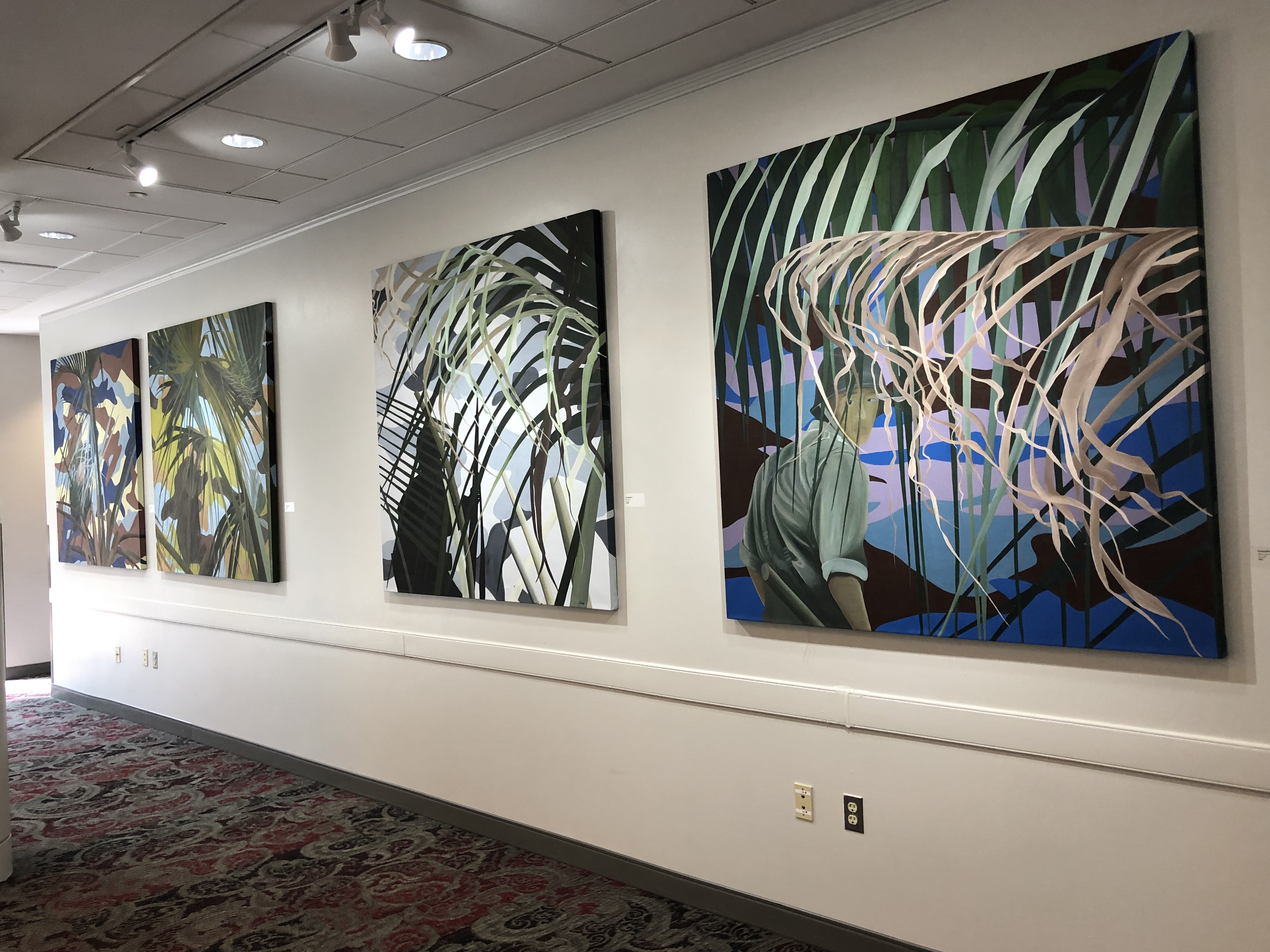
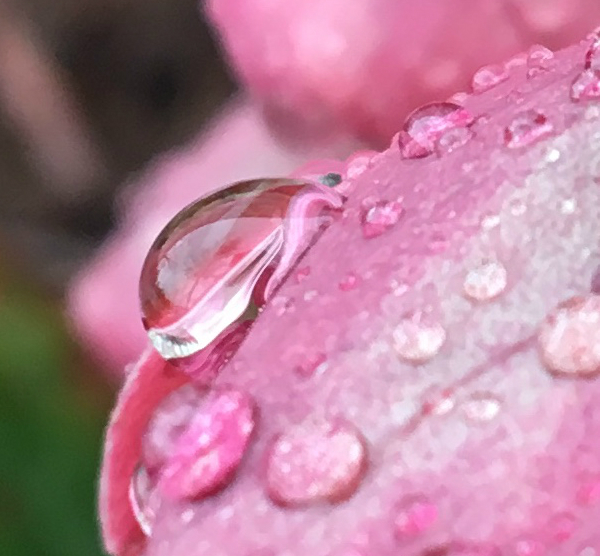
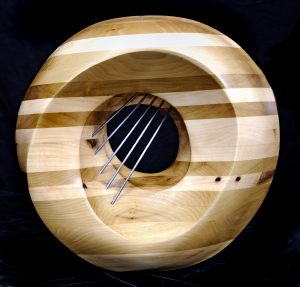
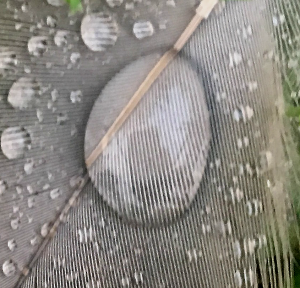

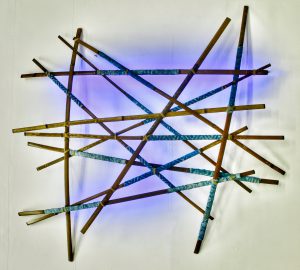 We pleased to present work from two of Alonzo Davis’s recent series, the Navigation Series and the Migrant Series. The Navigation Series is inspired by Alonzo’s long-time fascination with Micronesian navigation stick charts. Once used by the Marshall Islanders of Micronesia, the charts, studies of Pacific swell patterns and island locations, helped mariners navigate the waters in and around the region by canoe. The “Migrant Series” is a body of works that express our need for national and world concern of peoples having to leave their homeland because of inhumane conditions.The work in the series are approximately 14″w x 16″h x 5″d; each containing encaustic boats made of bamboo on a mixed media collage painting, with encaustic wax on board with burned and painted bamboo.
We pleased to present work from two of Alonzo Davis’s recent series, the Navigation Series and the Migrant Series. The Navigation Series is inspired by Alonzo’s long-time fascination with Micronesian navigation stick charts. Once used by the Marshall Islanders of Micronesia, the charts, studies of Pacific swell patterns and island locations, helped mariners navigate the waters in and around the region by canoe. The “Migrant Series” is a body of works that express our need for national and world concern of peoples having to leave their homeland because of inhumane conditions.The work in the series are approximately 14″w x 16″h x 5″d; each containing encaustic boats made of bamboo on a mixed media collage painting, with encaustic wax on board with burned and painted bamboo.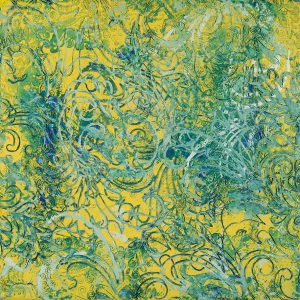 Angela White is a fine artist inspired by physical, spiritual and emotional memories that create the visual depth and density of her work. Abstracts and seascapes compose the majority of her compositions. Natural and sensual materials such as oils and encaustic paint allow the blending of edges to create visual depth. By superimposing layers of media, the varied themes and processes of her work are exposed.
Angela White is a fine artist inspired by physical, spiritual and emotional memories that create the visual depth and density of her work. Abstracts and seascapes compose the majority of her compositions. Natural and sensual materials such as oils and encaustic paint allow the blending of edges to create visual depth. By superimposing layers of media, the varied themes and processes of her work are exposed.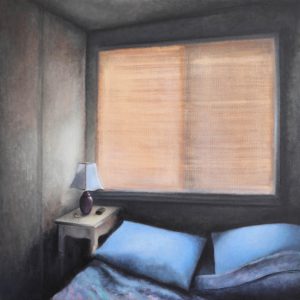
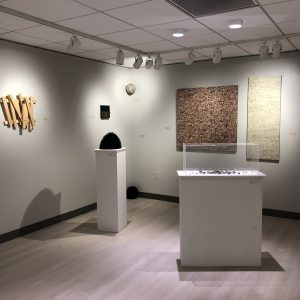 We are very pleased to invite you to an evening of artists talks with Lisa Noble and Travis Childers next Wednesday evening December 12th, 2018 6-8pm. Lisa and Travis have distinct visions where they explore memory and our experience of the day to moment.
We are very pleased to invite you to an evening of artists talks with Lisa Noble and Travis Childers next Wednesday evening December 12th, 2018 6-8pm. Lisa and Travis have distinct visions where they explore memory and our experience of the day to moment. Accumulations: Mixed Media works by Travis Childers is in the Fisher Art Gallery. Travis begins with everyday objects – newspaper clippings, staplers, pen tips and tops and transforms them into provocative objects that evoke the readymades of Duchamp and the process of the Dada movement of the 20th century.
Accumulations: Mixed Media works by Travis Childers is in the Fisher Art Gallery. Travis begins with everyday objects – newspaper clippings, staplers, pen tips and tops and transforms them into provocative objects that evoke the readymades of Duchamp and the process of the Dada movement of the 20th century.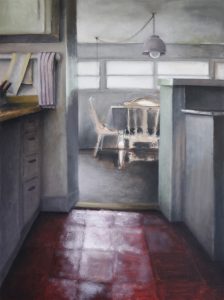 Memories of Home: Paintings by Lisa Noble is in the Passage Gallery. The interior in Lisa’s paintings are places of her past and personal history. They represent her efforts to visually map out the context of her childhood and early history.
Memories of Home: Paintings by Lisa Noble is in the Passage Gallery. The interior in Lisa’s paintings are places of her past and personal history. They represent her efforts to visually map out the context of her childhood and early history.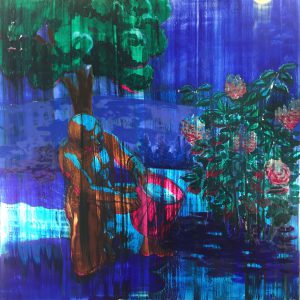 The Secret Garden: Paintings by Matt Pinney is in the Forum Gallery. Matt Pinney is an assistant professor of studio art at the Northern Virginia Community College at the Manassas Campus. Matt’s paintings employ personal myths, reinterpretations of history, and investigation of cultural assigned roles to creative narratives that are unbound by time.
The Secret Garden: Paintings by Matt Pinney is in the Forum Gallery. Matt Pinney is an assistant professor of studio art at the Northern Virginia Community College at the Manassas Campus. Matt’s paintings employ personal myths, reinterpretations of history, and investigation of cultural assigned roles to creative narratives that are unbound by time.
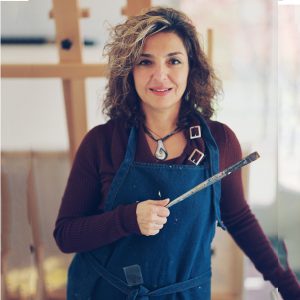 Say Behnam’s solo exhibition of paintings, Capturing the Vibrant, Transient and Eternal NOW is on display through November 4, 2018. We will be hosting a demonstration of the process that Saya uses to create her paints from plants, flowers, spices as well as stones and minerals next Tuesday October 30 12am – 2PM in the Forum Gallery of the Schlesinger Arts Center.
Say Behnam’s solo exhibition of paintings, Capturing the Vibrant, Transient and Eternal NOW is on display through November 4, 2018. We will be hosting a demonstration of the process that Saya uses to create her paints from plants, flowers, spices as well as stones and minerals next Tuesday October 30 12am – 2PM in the Forum Gallery of the Schlesinger Arts Center.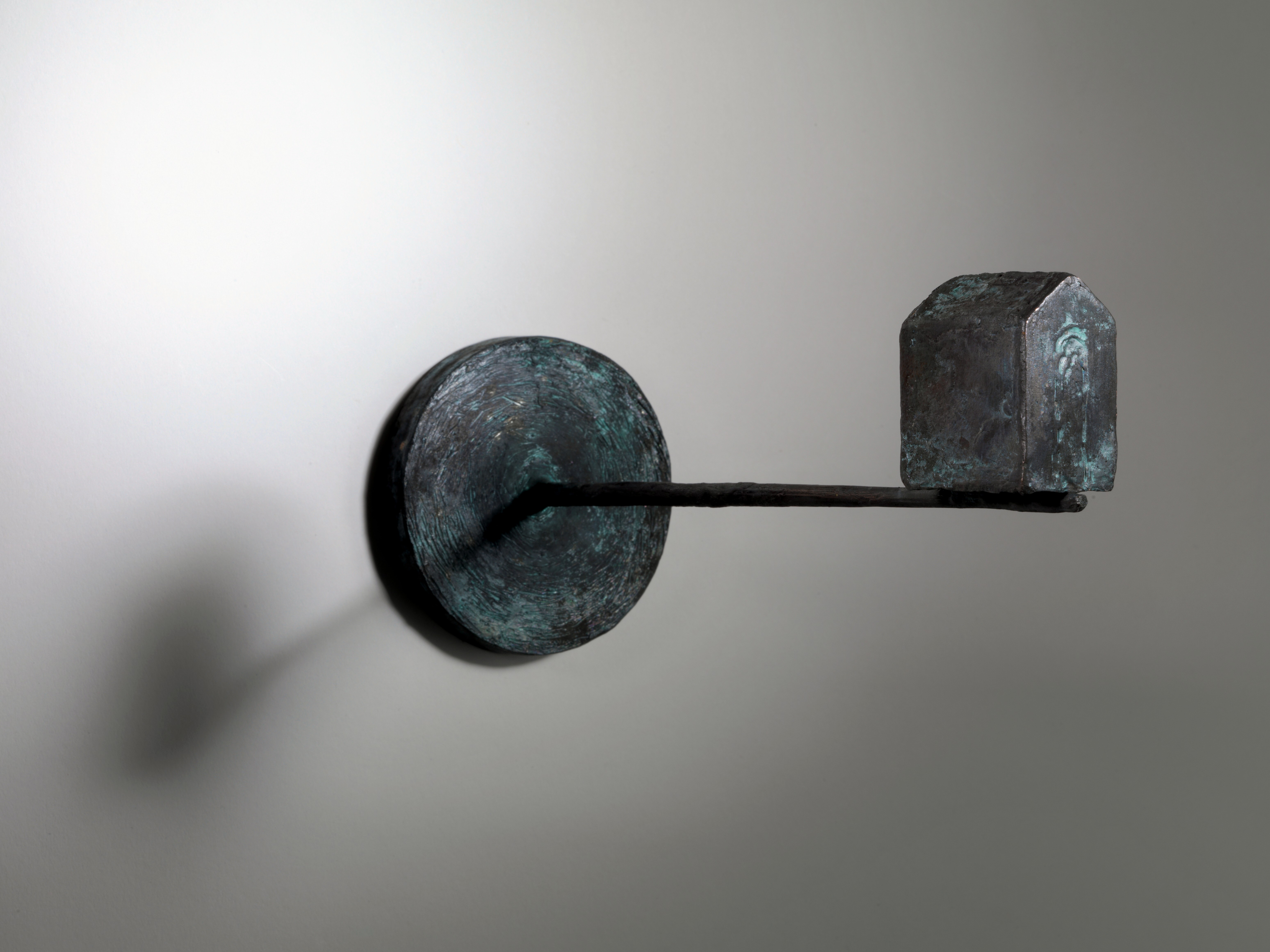
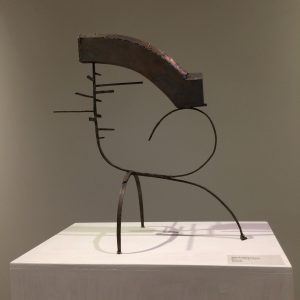 At VCU I decided to study “sculpture” because the Sculpture Department did not restrict sculpture to any working method. Our critiques addressed: concept, intent and effect.
At VCU I decided to study “sculpture” because the Sculpture Department did not restrict sculpture to any working method. Our critiques addressed: concept, intent and effect.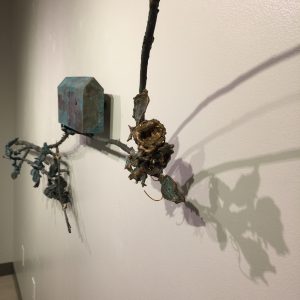 There is not a particular movement although I like art history a lot and literature is amazing. Art is an ancient language that repeats itself so I like to learn from the language of art.
There is not a particular movement although I like art history a lot and literature is amazing. Art is an ancient language that repeats itself so I like to learn from the language of art.